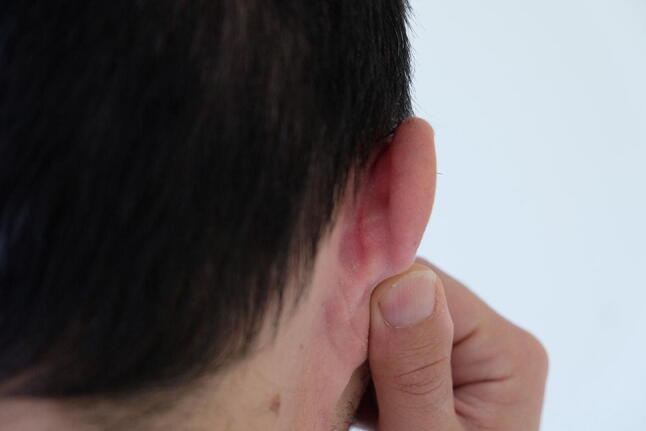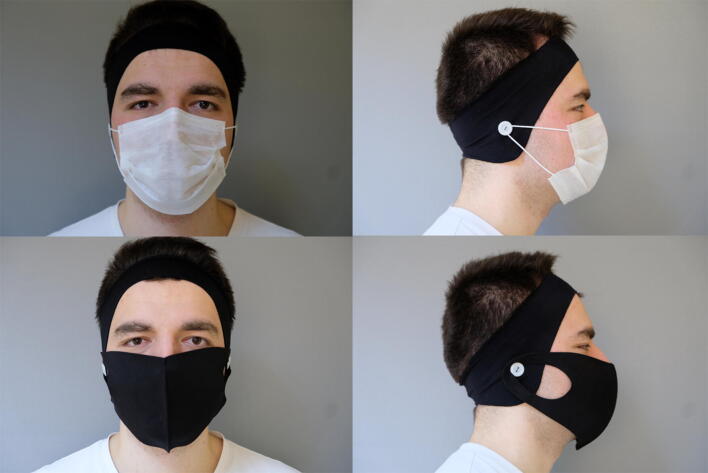Abstract
Abstract
In this letter, we describe an attachment on conventional headbands recommended for the postoperative period in prominent ear patients to confidently wear surgical masks without disturbing the posterior auricular incision.
Level of Evidence V
This journal requires that authors assign a level of evidence to each article. For a full description of these Evidence-Based Medicine ratings, please refer to the Table of Contents or the online Instructions to Authors www.springer.com/00266.
Keywords: Prominent ear, Surgical mask, Button headband, Covid-19, Pandemic, Aesthetic surgery, Patient security
Dear Sir,
Since the World Health Organization declared a global pandemic for the new coronavirus disease (COVID-19), self-protection and social distancing are strongly recommended to the global public for limiting the transmission of the disease [1]. Protective masks are proven to decrease contamination risk [2]. A variety of masks are being sold on the global market from the highly protective N95 masks to simple surgical masks. While highly protective masks are generally preferred for health care professionals, the general public prefers relatively cheaper simple surgical masks, or simple masks that are provided by some governments for free [3]. According to our observation, the majority of our patients are wearing simple surgical masks.
Surgical masks with one strap provide their support from the bilateral posterior auricular sulci and cause disturbing pain and hyperemia on the posterior pinna after excessive use (Fig. 1). The compression of the strip might be a problem such as pain and wound dehiscence for patients who have undergone operations associated with the posterior sulcus such as prominent ear surgery. In this scenario, one-stripped cheaper masks should be avoided and double strap highly protective masks should be advised to the patients. However, the affordability of double strap highly protective masks constitutes a problem in the pandemic [4]. Thus, we aimed to protect the incision of the posterior auricular sulcus from the compression of the mask strap in patients who have undergone prominent ear surgery by adding buttons to headbands that we generally recommend its utilization in the postoperative period.
Fig. 1.

View of a hyperemic posterior auricular sulcus due to compression of surgical mask
Preparation of Button Headband
The headband is worn on the head, and the location over the conchal region of the auricula is marked. Buttons (0.7-inch or 1-inch) are sewn to the right and left marked area (Fig. 2). A headband with buttons can be used with single-use one-strip protective masks or multiple useable masks. (Fig. 3).
Fig. 2.

Buttons (0.7 inch) are sewn to the previously marked points on the headband
Fig. 3.
(Above) Anterior and lateral view of the button headband with single-use surgical mask. (Below) Anterior and lateral view of the button headband with reusable non-surgical mask that patients commonly prefer in our region
Prominent ear surgery is one of the frequently performed aesthetic procedures. While the widely accepted approach for the prominent ear is from the posterior approach [5, 6], some authors use the anterior approach for correcting prominent ear deformity [7, 8]. Even in this circumstance, we still do not recommend wearing one-strap masks passing from the posterior auricular sulcus. The edema of the pinna can shadow the pain and compression sore of the strap and might lead to deeper lacerations in the swollen skin as a similar pathophysiology in hair tourniquet syndrome [9].
Although most departments have postponed elective cases in the pandemic, self-protection with masks and social distancing will likely last for a longer period of time. We think that our button headband would be an easily prepared and alternative outfit, compared to the double-strap masks, which patients may have difficulties in providing them after prominent ear surgery in the pandemic.
Compliance with Ethical Standards
Conflict of interest
The authors declare that study they have no conflicts of interest or disclose.
Statement of Human and Animal Rights or Ethical Approve
This article does not contain any studies with human participants or animals performed by any of the authors.
Footnotes
Publisher's Note
Springer Nature remains neutral with regard to jurisdictional claims in published maps and institutional affiliations.
Contributor Information
Burak Ozkan, Email: drburakozkan@gmail.com.
Cagri A. Uysal, Email: cagriuysal@hotmail.com
Nilgun M. Ertas, Email: nilmarkal@yahoo.com.tr
References
- 1.World Health Organization (2020) WHO declares COVID‐19 a pandemic. https://www.who.int/dg/speeches/detail/who-director-general-s-opening-remarks-at-the-media-briefing-on-covid-19-11-march-2020. Accessed 13 March 2020
- 2.Ma QX, Shan H, Zhang HL, Li GM, Yang RM, Chen JM. Potential utilities of mask wearing and instant hand hygiene for fighting SARS-CoV-2. J Med Virol. 2020 doi: 10.1002/jmv.25805. [DOI] [PMC free article] [PubMed] [Google Scholar]
- 3.Azap A, Erdinç FŞ. Medical mask or N95 respirator: when and how to use? Turk J Med Sci. 2020 doi: 10.3906/sag-2004-199. [DOI] [PubMed] [Google Scholar]
- 4.Bartoszko JJ, Farooqi MAM, Alhazzani W, Loeb M. Medical masks vs N95 respirators for preventing COVID-19 in healthcare workers: a systematic review and meta-analysis of randomized trials. Influenza Other Respir Viruses. 2020 doi: 10.1111/irv.12745. [DOI] [PMC free article] [PubMed] [Google Scholar]
- 5.Janz BA, Cole P, Hollier LH, Jr, Stal S. Treatment of prominent and constricted ear anomalies. Plast Reconstr Surg. 2009;124(1 Suppl):27e–37e. doi: 10.1097/PRS.0b013e3181aa0e9d. [DOI] [PubMed] [Google Scholar]
- 6.Lee Y, Kim YS, Lee WJ, Rha DK, Kim J. Proposal of a classification system for the assessment and treatment of prominent ear deformity. Aesthet Plast Surg. 2018;42(3):759–765. doi: 10.1007/s00266-017-1061-2. [DOI] [PubMed] [Google Scholar]
- 7.Erol OO. New modification in otoplasty: anterior approach. Plast Reconstr Surg. 2001;107(1):193–205. doi: 10.1097/00006534-200101000-00032. [DOI] [PubMed] [Google Scholar]
- 8.Stewart KJ, Lancerotto L. Surgical otoplasty: an evidence-based approach to prominent ears correction. Facial Plast Surg Clin N Am. 2018;26(1):9–18. doi: 10.1016/j.fsc.2017.09.002. [DOI] [PubMed] [Google Scholar]
- 9.Gottlieb M, Holladay D, Spearman D. Current approach to the evaluation and management of hair-thread tourniquets. Pediatr Emerg Care. 2019;35(5):377–379. doi: 10.1097/PEC.0000000000001827. [DOI] [PubMed] [Google Scholar]



